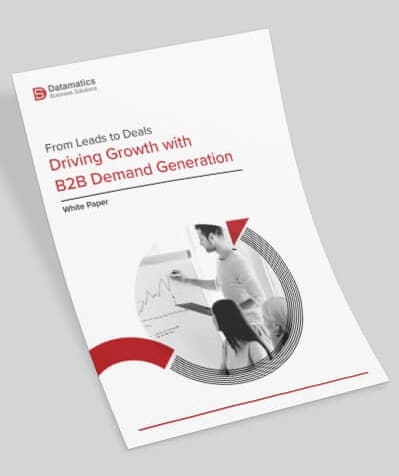As B2B sales and marketing managers, we all dream of landing those high-value deals. But let’s face it, they’re hard to come by. If you’re aiming for high-value contracts, you need more than luck. You need a solid sales strategy.
That’s where target account selling (TAS) comes in. TAS isn’t about throwing everything at the wall and hoping something sticks; it’s about precision and quality over quantity. It helps turn your sales reps into trusted advisors who can guide prospects every step of the way.
TAS represents a personalized approach to B2B prospecting. It’s where sales and marketing teams zero in on a specific company, creating a unique sales plan just for them. And yes, it does require more work upfront from sales teams, but the payoff can be huge with high-quality leads who are genuinely interested. In this blog, we take a close look into target account selling, exploring not only its implementation challenges but also the key steps needed to successfully execute it.
The Challenges of Implementing Target Account Selling
When it comes to TAS, sales teams focus on thoroughly researching the perfect prospects for their product. This approach often leads to valuable leads that are eager to make a purchase. In essence, TAS acts as a powerful tool to strengthen your sales pipeline and reduce the duration of your sales cycle.
However, it’s essential to understand that implementing target account selling can be challenging. It demands a dedicated team of salespeople and marketers working closely together, ready to adapt seamlessly to various challenges as they arise. Sales success through TAS doesn’t happen overnight, so it’s crucial not to view it as a quick solution to boost sales at the end of a quarter. Instead, consider it a long-term sales strategy that requires your team to have the capacity to manage it alongside other selling initiatives.
Before implementing TAS, here’s what you’ll need:
• Sufficient resources
If your sales team is on the smaller side, rolling out TAS might not be the best move. TAS often requires a dedicated Sales Development Representative (SDR) solely focused on researching multiple decision-makers within a target company. TAS can be a game-changer if your revenue and team size allow for such roles. However, it might be wise to hold off for now if resources are tight.
• Strong Ideal Customer Profile (ICP)
While most marketing and sales teams have an ICP, TAS demands a highly accurate one to thrive. This can be challenging for smaller firms with limited customer data, resulting in thin and unreliable ICPs.
• Excellent CRM platform
TAS requires meticulous tracking of numerous profiles and activities. A dependable CRM with advanced features is crucial for keeping tabs on prospects throughout the sales journey.
• Time
TAS isn’t a quick fix for immediate sales boosts or preventing layoffs. It requires a significant investment of time and patience. Before diving in, have candid discussions about the timeframe required and whether your company can commit to it.
Mastering TAS: A Breakdown of the Four Essential Steps
Building your TAS strategy isn’t something you can rush. It demands teamwork and dedication from everyone involved. However, the potential rewards are huge, with revenue growth waiting at the finish line. That’s why it’s crucial to understand and execute each step of TAS carefully. Remember, it’s about quality over speed, so take your time to ensure you’re setting yourself up for success from the start.
Step 1: Set your goals
Before jumping into TAS, it’s essential to know why you’re considering it. Since it’s a significant investment of time and energy, having clear objectives to track and defend is key. Take some time to list 3-5 specific goals you want TAS to achieve within a quarter.
These goals may vary depending on your organization’s unique situation, but here are some good starting points:
- Strengthening the quality of your sales pipeline.
- Increasing deal closures and improving conversion rates.
- Introducing more opportunities for upselling or cross-selling to accounts acquired through TAS.
Step 2: Define Your ideal customer profile (ICP)
This step is crucial in the TAS process. As mentioned earlier, having a well-crafted Ideal Customer Profile (ICP) is key to making the most of TAS. However, it’s essential to dig deeper to truly understand who your target audience is.
Building on your existing ICP, conduct thorough research to pinpoint potential targets. Here are some key aspects to consider:
- Explore their company’s profile:
Take a close look at factors like company size, revenue, and growth trends. Traditional ICPs might miss subtle details, so explore aspects to gain a deeper understanding. - Assess their tech stack:
Find out if they’re using competitors’ software and how your product could fit into their tech ecosystem. Determine if their technology setup aligns well with what your product offers. - Gauge their interest in your product:
Keep an eye out for signs of interest, such as social media engagement or recent funding rounds indicating potential investment in technology upgrades. Stay attuned to each prospect’s level of interest to tailor your approach accordingly.
How you shape this ICP is up to your sales and marketing team. Some teams take it a step further by crafting ICPs for individual decision-makers within a company. Others create ICPs tailored to specific roles, such as Chief Product Officers (CPOs), or even different departments. While there’s no definitive right or wrong approach, aiming for specificity tends to yield better results. So, the more detailed and targeted your ICP is, the more effective it usually is.
Step 3: Refine your list and plan your approach
Using your Ideal Customer Profile (ICP) as a guide, narrow down your list of prospects to around 10 or 20. Dive deep into research, considering all the data we’ve discussed, along with any other relevant information, to gauge the likelihood of closing a deal. Once you’ve trimmed your list, it’s time to map out a timeline for reaching out to these accounts.
When implementing TAS, it’s essential to be strategic in your approach. Utilize firmographic data to decide who to contact first within each organization. Typically, it’s wise to start with someone at a lower level before reaching out to C-level executives. This approach allows you to effectively test your tailored value propositions and calls to action. However, if a company is showing strong buying signals, targeting a higher-level executive may be a good move.
Now that you’ve identified your target accounts and mapped out your initial contacts, collaborate with your marketing team to craft compelling value propositions. Remember, TAS thrives on personalized communication, so steer clear of generic email templates or cold calls. Instead, craft engaging pitches that showcase your understanding of the prospect’s needs and demonstrate how your solution can address their specific challenges.
Step 4: Dive into the sales process
While it might be tempting to think you’ll seal that $100k deal right away, it’s not always that simple. TAS can speed up the sales cycle but often involves trial and error.
Keep a close eye on where each client stands in the sales funnel. Take detailed notes after every call and email exchange. Engage with different departments within the organization to ensure everyone is ready for the conversion. For target account selling to work smoothly, your sales team needs to be responsive and adaptable, understanding every conversation and the position of key decision-makers. Your CRM system will be put to good use, and once you secure a significant deal, it’ll all be worth it.
But remember, closing a deal isn’t the end. TAS is an ongoing mindset. Set milestones for your customers and check in regularly to ensure they’re making progress. Seeing real results will open opportunities for future upselling or cross-selling, making the effort to target the customer initially truly worthwhile.
Unleashing Sales & Marketing Synergy: The Power of TAS & ABM Integration
Now that you’ve got a handle on how TAS works, let’s tackle the age-old question: how does it differ from Account-Based Marketing (ABM), and how do they complement each other? TAS helps in closing deals through personalized sales strategies, leveraging customer insights to seal the deal effectively. On the flip side, ABM focuses on nurturing client relationships through tailored marketing campaigns, providing valuable content and updates to keep them engaged beyond the sales pitch.
While they may have different end goals, TAS and ABM share a common ground in leveraging data to target the right people within target accounts. This is where they truly shine together: TAS hones in on closing deals, while ABM builds and maintains relationships. When integrated seamlessly, these strategies create a powerhouse approach that maximizes sales and fosters long-term client connections.
To amp up your emails, break down your subscribers into smaller groups based on their interests. Then, send them emails that feel like they were crafted just for them.
Conclusion
Target account selling isn’t just another run-of-the-mill sales tactic; it’s a dynamic and strategic approach that can truly supercharge your sales team’s performance. By focusing your efforts on high-value accounts and sticking to the structured TAS process, your business can reach unprecedented levels of success in its sales endeavors.
If you wish to take your sales strategy to the next level, explore the world of account-based marketing for a smarter and more effective approach. Discover practical ways to generate B2B leads that perfectly complement your TAS strategy. Reach out to us at [email protected] and let’s make it happen together.
 Select an element to maximize. Press ESC to cancel.
Select an element to maximize. Press ESC to cancel.
Paul van de Kamp


